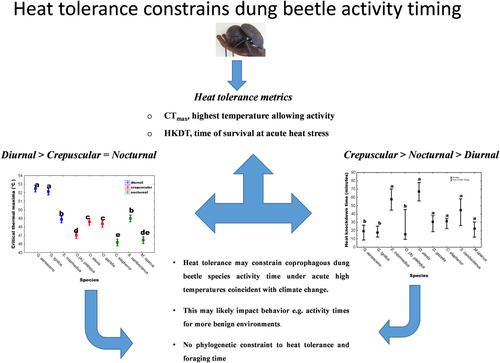当前位置:
X-MOL 学术
›
Insect Sci.
›
论文详情
Our official English website, www.x-mol.net, welcomes your
feedback! (Note: you will need to create a separate account there.)
Heat tolerance may determine activity time in coprophagic beetle species (Coleoptera: Scarabaeidae)
Insect Science ( IF 2.9 ) Pub Date : 2020-06-22 , DOI: 10.1111/1744-7917.12844 Nonofo Gotcha 1 , Honest Machekano 1 , Ross N Cuthbert 2 , Casper Nyamukondiwa 1
Insect Science ( IF 2.9 ) Pub Date : 2020-06-22 , DOI: 10.1111/1744-7917.12844 Nonofo Gotcha 1 , Honest Machekano 1 , Ross N Cuthbert 2 , Casper Nyamukondiwa 1
Affiliation

|
Although reports have documented loss of species diversity and ecological services caused by stressful temperature changes that result from climate change, some species cope through behavioral compensation. As temperatures and magnitudes of temperature extremes increase, animals should compensate to maintain fitness (such as through temporary behavioral shifts in activity times). Appropriate timing of activity helps avoid competition across species. Although coprophagic dung beetles exhibit species-specific temporal activity times, it is unknown whether temperature drives evolution of these species-specific temporal activity times. Using nine dung beetle species (three each of diurnal, crepuscular, and nocturnal species), we explored differences in heat stress tolerance measured as critical thermal maxima (CTmax; the highest temperature allowing activity) and heat knockdown time (HKDT; survival time under acute heat stress) across these species, and examined the results using a phylogenetically informed approach. Our results showed that day-active species had significantly higher CTmax (diurnal > crepuscular = nocturnal species), whereas crepuscular species had higher HKDT (crepuscular > nocturnal > diurnal species). There was no correlation between heat tolerance and body size across species with distinct temporal activity, and no significant phylogenetic constraint for activity. Species with higher CTmax did not necessarily have higher HKDT, which indicates that species may respond differently to diverse heat tolerance metrics. Acute heat tolerance for diurnal beetles indicates that this trait may constrain activity time and, under high acute temperatures with climate change, species may shift activity times in more benign environments. These results contribute to elucidate the evolution of foraging behavior and management of coprophagic beetle ecosystem services under changing environments.
中文翻译:

耐热性可能决定食粪甲虫物种(鞘翅目:金龟科)的活动时间
尽管报告记录了气候变化导致的压力性温度变化导致物种多样性和生态服务的丧失,但一些物种通过行为补偿来应对。随着温度和极端温度幅度的增加,动物应该进行补偿以保持健康(例如通过活动时间的临时行为变化)。适当的活动时间有助于避免跨物种的竞争。尽管食粪甲虫表现出特定物种的时间活动时间,但尚不清楚温度是否会驱动这些特定物种时间活动时间的进化。使用九种蜣螂(昼行、黄昏和夜间各三种),我们探索了热应激耐受性的差异,测量为临界热最大值(CT max; 允许活动的最高温度)和热击倒时间(HKDT;急性热应激下的存活时间),并使用系统发育知情方法检查结果。我们的结果表明,白天活动的物种具有显着更高的 CT最大值(昼夜 > 黄昏 = 夜间物种),而黄昏物种具有更高的 HKDT(黄昏 > 夜间 > 昼夜物种)。具有不同时间活动的物种之间的耐热性和体型之间没有相关性,并且对活动没有显着的系统发育约束。具有更高 CT最大值的物种不一定具有更高的 HKDT,这表明物种可能对不同的耐热性指标做出不同的反应。昼夜甲虫的急性耐热性表明这种特性可能会限制活动时间,并且在气候变化的高急性温度下,物种可能会在更温和的环境中改变活动时间。这些结果有助于阐明在不断变化的环境下觅食行为的演变和食粪甲虫生态系统服务的管理。
更新日期:2020-06-22
中文翻译:

耐热性可能决定食粪甲虫物种(鞘翅目:金龟科)的活动时间
尽管报告记录了气候变化导致的压力性温度变化导致物种多样性和生态服务的丧失,但一些物种通过行为补偿来应对。随着温度和极端温度幅度的增加,动物应该进行补偿以保持健康(例如通过活动时间的临时行为变化)。适当的活动时间有助于避免跨物种的竞争。尽管食粪甲虫表现出特定物种的时间活动时间,但尚不清楚温度是否会驱动这些特定物种时间活动时间的进化。使用九种蜣螂(昼行、黄昏和夜间各三种),我们探索了热应激耐受性的差异,测量为临界热最大值(CT max; 允许活动的最高温度)和热击倒时间(HKDT;急性热应激下的存活时间),并使用系统发育知情方法检查结果。我们的结果表明,白天活动的物种具有显着更高的 CT最大值(昼夜 > 黄昏 = 夜间物种),而黄昏物种具有更高的 HKDT(黄昏 > 夜间 > 昼夜物种)。具有不同时间活动的物种之间的耐热性和体型之间没有相关性,并且对活动没有显着的系统发育约束。具有更高 CT最大值的物种不一定具有更高的 HKDT,这表明物种可能对不同的耐热性指标做出不同的反应。昼夜甲虫的急性耐热性表明这种特性可能会限制活动时间,并且在气候变化的高急性温度下,物种可能会在更温和的环境中改变活动时间。这些结果有助于阐明在不断变化的环境下觅食行为的演变和食粪甲虫生态系统服务的管理。











































 京公网安备 11010802027423号
京公网安备 11010802027423号